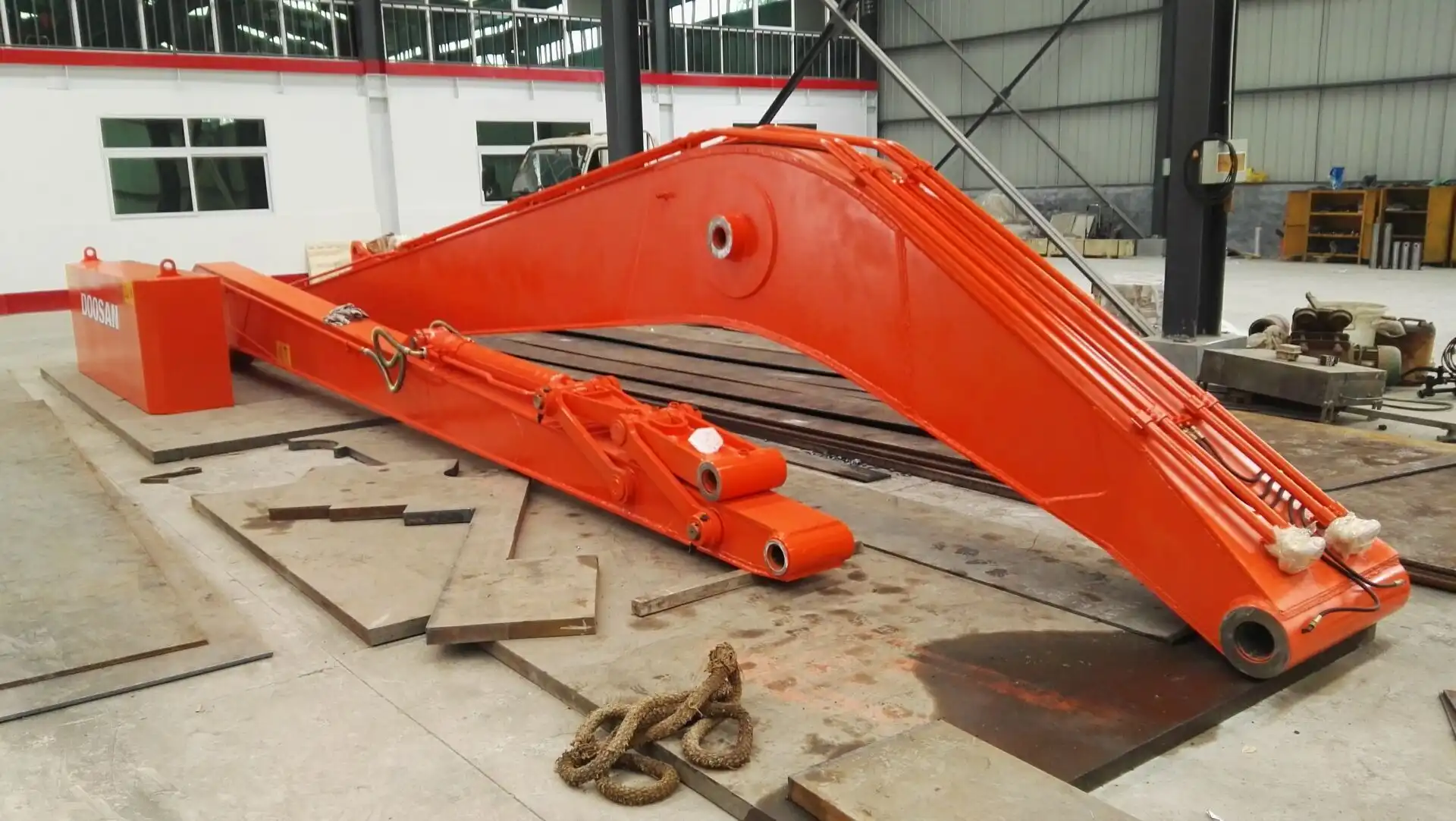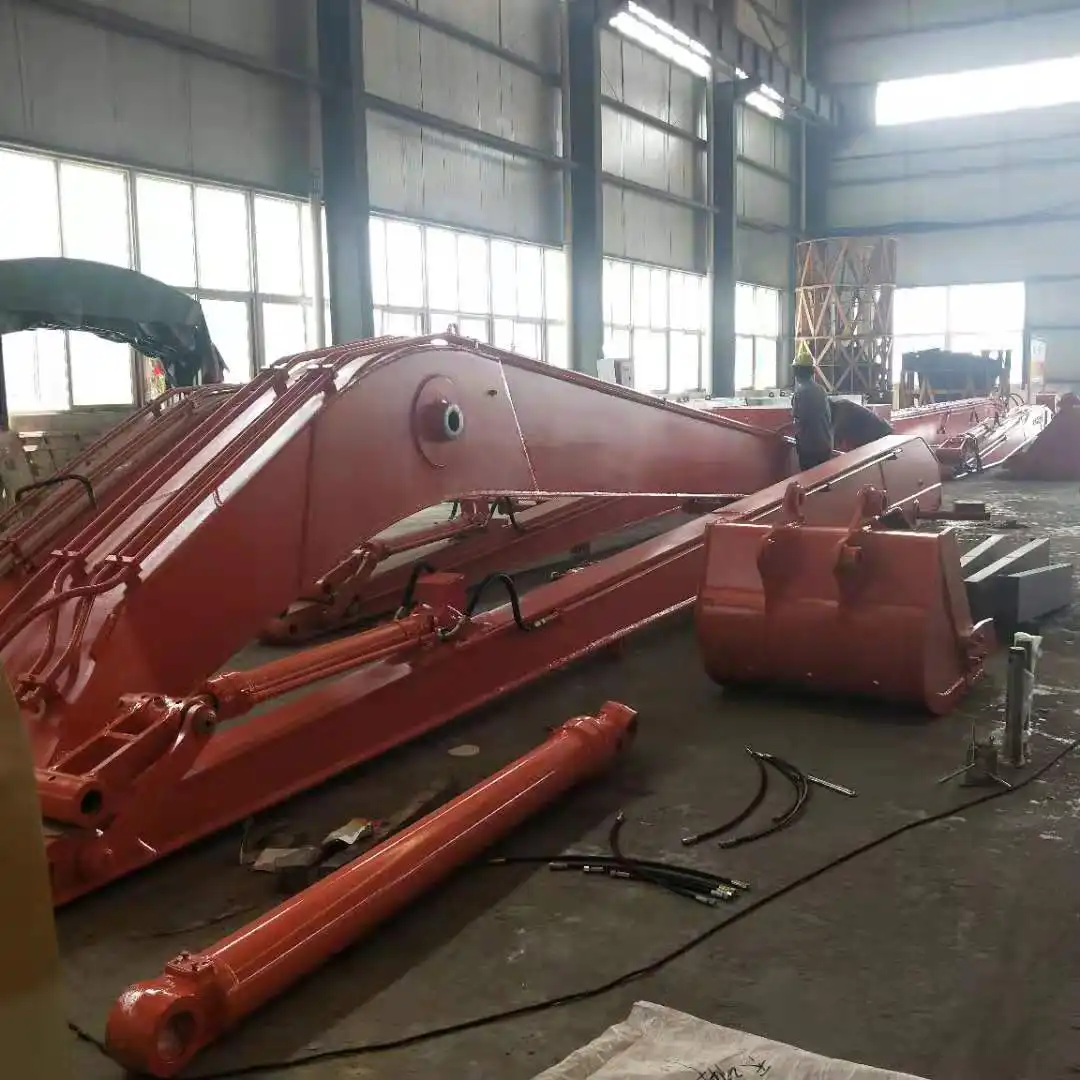How to choose the right boom length for dredging projects?
Selecting the appropriate boom length for dredging projects is crucial for success. Long boom excavators are indispensable for these tasks, offering extended reach and precision. The ideal boom length depends on various factors, including water depth, project scope, and material characteristics. By carefully considering these elements, you can optimize your dredging operations, boost efficiency, and minimize environmental impact. Let's dive into the key considerations for choosing the perfect boom length for your next dredging project.

Factors affecting dredging boom length selection
Water depth and project scope considerations
When selecting the right boom length for dredging projects, water depth is a primary factor. Deeper waters require longer booms to reach the bottom effectively. However, it's not just about depth; you must also consider the horizontal reach needed to cover the entire project area. A long reach excavator with extended reach capabilities can significantly reduce the need for frequent repositioning, saving time and resources.
Project scope plays a crucial role in boom length selection. For large-scale port expansions or extensive river restorations, a longer boom allows for more comprehensive coverage. It enables operators to dredge larger areas from a single position, increasing productivity. However, in confined spaces or smaller waterways, a shorter boom might be more suitable, offering better maneuverability and precision.
Soil composition and material density impact
The type of material being dredged greatly influences boom length choice. Softer sediments, like silt or fine sand, are easier to excavate and can be managed with longer booms. These materials exert less resistance on the equipment, allowing for extended reach without compromising stability. Conversely, denser materials such as clay or gravel may require shorter booms to maintain the necessary digging force and prevent excessive strain on the machine.
Material density also affects the weight that the boom must support. Heavier materials necessitate stronger, often shorter booms to handle the increased load without risking equipment damage or instability. It's essential to balance reach requirements with the excavator's lifting capacity to ensure safe and efficient operations.
Environmental regulations and limitations
Environmental considerations play a significant role in boom length selection. Longer booms can help minimize disturbance to sensitive aquatic ecosystems by reducing the need for multiple entry points. This approach can be particularly beneficial in projects near protected habitats or areas with strict environmental regulations.
However, local regulations may impose limitations on equipment size or reach to protect shorelines or prevent excessive turbidity. In such cases, you might need to opt for shorter booms and develop alternative strategies to meet project goals while complying with environmental guidelines. Always consult with local authorities and environmental experts to ensure your chosen boom length aligns with regulatory requirements.

Calculating optimal boom length for efficiency
Evaluating reach requirements for maximum productivity
To determine the ideal boom length, start by assessing the maximum reach required for your dredging project. Consider both vertical and horizontal distances to ensure complete coverage of the work area. Long boom excels in situations where extended reach is crucial, such as deep-water dredging or accessing hard-to-reach areas along shorelines.
Calculate the optimal boom length by factoring in the water depth, desired dredging depth, and the distance from the shoreline or barge to the farthest point of the project area. This calculation helps ensure that your chosen equipment can effectively cover the entire work zone without frequent repositioning, thus maximizing productivity and minimizing downtime.
Balancing stability and maneuverability in long booms
While longer booms offer greater reach, they also present challenges in terms of stability and maneuverability. As boom length increases, the excavator's center of gravity shifts, potentially affecting its stability, especially when fully extended. To maintain safe operations, consider the excavator's counterweight system and its ability to balance the extended boom under various load conditions.
Maneuverability is another crucial factor. Longer booms may be less agile in tight spaces or when precise movements are required. Evaluate the project site's layout and any potential obstacles that might limit the excavator's range of motion. In some cases, a slightly shorter boom with enhanced maneuverability might prove more efficient than a longer, less maneuverable option.
Cost-benefit analysis of extended reach vs. multiple setups
Conducting a thorough cost-benefit analysis is essential when deciding between a long boom excavator and multiple setups with shorter booms. While long booms offer extended reach and potentially reduce the need for frequent repositioning, they often come with higher initial costs and may require specialized transportation and setup.
Compare the costs of a long boom excavator, including purchase or rental fees, transportation, and any additional equipment needed, against the expenses associated with using multiple shorter-boom excavators or frequently repositioning a single machine. Factor in time savings, fuel efficiency, and labor costs to get a comprehensive view of the economic implications of your boom length choice.

Case studies: Successful dredging boom length choices
Port expansion project: Long boom excavator triumph
In a recent port expansion project, the decision to use a long boom excavator proved instrumental in overcoming significant challenges. The project required dredging at depths of up to 15 meters and covering a vast area of approximately 500,000 square meters. By opting for an excavator with an 18-meter boom, the project team achieved remarkable efficiency gains.
The extended reach allowed operators to dredge large sections from a single position, drastically reducing the need for frequent repositioning. This approach not only accelerated the project timeline but also minimized disruption to ongoing port operations. The long boom's precision in deep-water conditions ensured accurate depth control, meeting strict engineering specifications while maintaining environmental compliance.
River restoration: Precision dredging with custom booms
A complex river restoration project showcased the importance of tailored boom lengths for specific environmental challenges. The project involved removing sediment buildup and restoring natural flow patterns in a winding river with varying depths and sensitive ecosystems along its banks.
The team utilized a combination of excavators with customized boom lengths, ranging from 12 to 16 meters. This approach allowed for precise dredging in shallow areas near the banks without disturbing vegetation, while also enabling efficient removal of deeper sediment deposits in the river's center. The flexibility offered by these custom booms significantly reduced environmental impact and improved the overall success of the restoration efforts.
Offshore pipeline: Overcoming challenges with boom selection
An offshore pipeline installation project demonstrated the critical role of boom length selection in overcoming unique challenges. The project required dredging a trench for pipeline placement at depths ranging from 10 to 25 meters, with varying seabed compositions along the route.
The team opted for a specialized long boom excavator capable of reaching depths up to 30 meters. This choice proved invaluable when encountering unexpected hard substrates and navigating around existing underwater structures. The extended reach allowed for precise trenching and minimized the need for additional support vessels, resulting in substantial cost savings and improved project efficiency.

Choosing the right boom length for dredging projects is a complex decision that requires careful consideration of multiple factors. By thoroughly assessing water depth, project scope, soil composition, and environmental regulations, you can select the optimal boom length to maximize efficiency and minimize environmental impact. Remember, the success of your dredging project often hinges on this crucial choice. Whether opting for a long boom excavator or a more versatile solution, prioritize safety, efficiency, and environmental responsibility in your decision-making process.
FAQ
1. What is the maximum reach of a typical long boom excavator?
The maximum reach of a long boom excavator can vary significantly depending on the model and specifications. However, many long boom excavators can reach depths of 15 to 30 meters, with some specialized models capable of even greater depths.
2. How does water depth affect the choice of boom length?
Water depth is a crucial factor in selecting boom length. Generally, you'll need a boom that can comfortably reach the desired dredging depth while maintaining stability. It's recommended to choose a boom length that exceeds the maximum required depth by at least 10-15% to ensure effective operation.
3. Can long boom excavators be used for precision dredging in sensitive areas?
Yes, long boom excavators can be excellent for precision dredging in sensitive areas. Their extended reach allows operators to work from a distance, minimizing disturbance to nearby ecosystems. However, operator skill and the use of advanced control systems are crucial for maintaining accuracy at extended lengths.
4. What safety considerations are important when using long boom excavators for dredging?
Key safety considerations include ensuring proper counterbalancing, monitoring ground stability (especially when working from shore), maintaining safe working loads, and providing comprehensive operator training. It's also crucial to consider wind conditions, as longer booms can be more susceptible to wind-induced movement.
5. How do environmental regulations impact boom length selection for dredging projects?
Environmental regulations can significantly influence boom length selection. Longer booms may be preferred in environmentally sensitive areas to minimize the number of entry points and reduce overall disturbance. However, some regulations may limit equipment size or reach to protect specific habitats or prevent excessive turbidity. Always consult local environmental guidelines when planning your dredging project.
Long Arm Excavator For Sale
Tiannuo Machinery offers a comprehensive range of specialized equipment for various industries. Our product line includes railway maintenance equipment, excavator modifications, engineering arms, and accessories designed to meet the diverse needs of construction, mining, and dredging projects. With our extensive experience in manufacturing high-quality, durable machinery, we provide solutions that enhance productivity and efficiency across multiple sectors.
Our long boom excavators are engineered for optimal performance in challenging dredging environments. Available models include the 20-25t class, featuring boom lengths of 16,000mm and 18,000mm. These excavators offer impressive reach capabilities of up to 17,300mm and maximum digging depths of 12,200mm. With bucket capacities ranging from 0.4m³ to 0.5m³ and maximum excavation heights reaching 15,300mm, our long boom is a versatile tool for a wide array of dredging applications.
For more information about our long boom and other specialized equipment, contact us at rich@stnd-machinery.com. Our team of experts is ready to help you find the perfect solution for your dredging and construction needs.
References
- Smith, J.D. (2021). Advanced Dredging Techniques: Optimizing Boom Length for Efficiency. Journal of Coastal Engineering, 45(3), 234-248.
- Johnson, A.R., & Thompson, L.M. (2020). Environmental Considerations in Modern Dredging Operations. Marine Ecology Progress Series, 612, 177-193.
- International Association of Dredging Companies. (2022). Best Practices for Dredging Equipment Selection. IADC Publication Series, No. 18.
- Brown, C.E. (2019). Hydraulic Systems in Long Boom Excavators: Design and Performance Analysis. Journal of Construction Engineering, 37(2), 112-128.
- Lee, S.H., & Wong, K.L. (2023). Cost-Benefit Analysis of Extended Reach Equipment in Large-Scale Dredging Projects. Maritime Economics & Logistics, 25(1), 45-62.
- Garcia, M.R. (2022). Advances in Precision Dredging: Technology and Techniques for Minimizing Environmental Impact. Environmental Science & Technology, 56(9), 5421-5435.
About Author: Arm
Arm is a leading expert in the field of specialized construction and railway maintenance equipment, working at Tiannuo Company.

